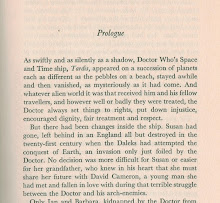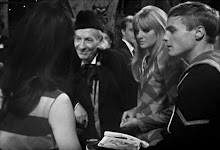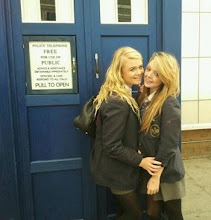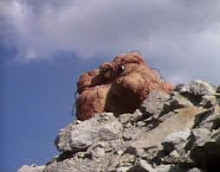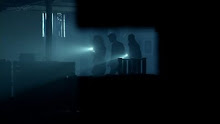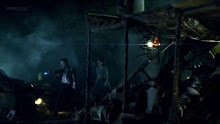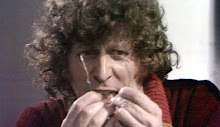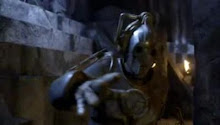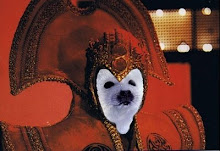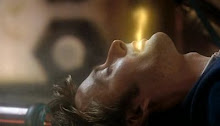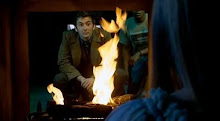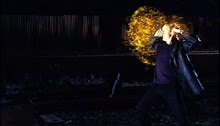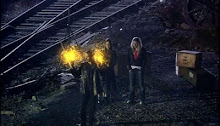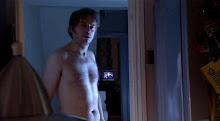
December. Night comes in early now. See me there, four years old and therefore this tall, standing on a similarly dwarfish example of Habitat furniture and tacking tinsel to the wall at a level which I naively consider to be Quite High Up. My mother - my only co-habitant in this flat, in a building that 2012-me would describe as a product of Modernist utopianism ruined by mid-twentieth-century politics and lifts that never bloody work - is doing the same. I'm helping, in a way that only children fully understand. This home is harsh and angular and green-grey, a period green-greyness that belongs in the 1970s and absolutely nowhere else. There are orange-and-brown curtains elsewhere in these rooms, as per. But right now there's also tinsel on the walls. Hah! Purple wins the day. A last-minute victory for Glam before we all slide into the sludge of MOR.
At this exact moment, there are two things on television. At the same time, on the same channel. One is the pre-Christmas edition of Top of the Pops, which sees Boney M performing "By the Rivers of Babylon", but also - by a further splitting of universes, which even the CEO of an American comic-book company would find hard to sell - perfoming "Mary's Boy Child" simultaneously. The other programme is the festive repeat of "Pyramids of Mars", being delivered in one large seasonal package instead of the original four. I'm not consciously aware of this last fact, of course, but I can hardly ignore the thing whose gaze now takes in the whole of this living-room from behind the glass. The dark and - yay! - purple-tinged god. Eyes lighting up in a horror of turquoise. I knew Sutekh before I even knew what Egypt was.
Egypt. Babylon. Gods. Christmas. My first memory was of a giraffe, and it taught me fear, embarrassingly. Sutekh doesn't scare me. Sutekh is fascination.
Last Christmas, "Bohemian Rhapsody" was number one, and on Top of the Pops every week forever. At my grandparents' house (once again), I was so appalled by this clutch of chanting, illuminated heads that I ran into the kitchen and barricaded the door with my tiny body until I received assurances from three impartial grown-ups that it was over. Queen was fear. Doctor Who was compulsion. Those who talk about "behind the sofa" moments tend to be children of the '60s, when 405-line monochrome was blurry enough to give you a sense of something terrible lurking behind the (often deliberately-employed) fuzz. Children of the '70s, watching the same series shot on then-hi-def, then-ultra-sharp video... many of us didn't even know we were meant to be scared, until nostalgia programmes started telling us so, ten years later. Perhaps the occasional episode would hit on a specific personal phobia, be it spiders, living statues, or in my mother's strangely Freudian case, men with the heads of bulls; however, the ideal of Doctor Who as an all-purpose Engine of Terror disappeared in 1969, and wouldn't be forced back into existence until the twenty-first century.
"The Wheel in Space" scared four-year-olds. "Revenge of the Cybermen" never could, not even if you still had a black-and-white TV. As my grandparents did until 1980, although retrospect still guarantees that I remember both My First Sontaran and "Bohemian Rhapsody" in colour...
...how strange. This had never occurred to me before. Black-and-white sets were so common in the mid-'70s that you were trained, unconsciously, to fill in the pictures for yourself. Perhaps we thought that was the point of the ad-breaks on ITV. A pause for what we'd now call "rendering".
Top of the Pops and Doctor Who. As BBC4 will joyfuily demonstrate, after 1976, the former was a grunting cackspasm of adult-oriented rock and self-deluding DJs, with occasional grinning white boys attempting reggae. Yet alienness and Glam Rock had twisted themselves together in the years beforehand, even sharing the same BBC-issue visual effects. Later on, they'd join up again, but we'll come to that when "Ashes to Ashes" meets John Nathan-Turner and "Warriors' Gate" provides the missing link between Alice Cooper and Adam Ant. For now, we'll return to 1976, where we can say this for certain:
Rationally, there's no way these two BBC1 presentations can be broadcast at the same time. Boney M and the Eye of Horus can't co-exist on a single screen, not with this decade's technology. A conflated memory? Two types of spectacle on the same evening, or two events separated by months / years, linked by nostalgia rather than fact? Was "Pyramids of Mars" even repeated at Christmas...? There's a book on the shelf three feet to my right that would tell me for certain, but on this occasion, I'd rather not know. Nobody's narrative has to be that precise.
What's interesting is that by now, Doctor Who seems an accepted part of my life. "Interesting" because toddlers have no control over television. No, wait: had no control. I had no concept of regular schedules for programmes, no idea that this new mind-game was there every Saturday, for a pre-determined segment of the year. Television happened, like weather. Even adults tended to think of it that way, in an age of two-and-a-half channels and no remote control. If you creatures of the 1980s ever wondered why audience appreciation indexes were so much lower in the days of your forefathers, then it's simple: in your world of the future, if you don't like what you're seeing, you click. Here in 1976, if you're not one of the jet-set few to have a crackfizzling portable in the bedroom, then you sit through the show with the rest of your family and complain afterwards. You give yourself up to the sofa, become ensconced in whatever environment BBC1 or ITV chooses to create for you on this particular evening. Curiously, the holodecks and "Veldt"-style VRs of the pretend-future seem closer to the experience of Old Telly than the interactive age.
So I not only liked Doctor Who, I'd developed the concept of liking something as a long-term proposition. I'd been sure of this ever since the Best Thing Ever, the previous year. One image, solid in my squishy, unformed memory but still (with hindsight) massively inaccurate: people on a balcony, overlooking the same south-of-Watford overpass / underpass world I saw every day through the back windows of a Singer Chamois, except with a whacking great dinosaur-thing rising up in the background and seething at the traffic. Oh, and perhaps best of all, the people on the balcony not being particularly bothered.
I'm well aware that the bit with the Skarasen at the end of "Terror of the Zygons" is regarded as one of the leading visual abominations of its time. Not merely because of the Shonk Ness Monster, but also because of Douglas Camfield's bizarre understanding of CSO, the result of a great '60s stylist being terribly unprepared for the '70s. To a then-three-year-old, it was the thought that mattered, the very possibility of these things existing side-by-side. I suspect I may already have been aware of the King Kong / Godzilla axis, although in later years, it'd become more obvious that rampage-porn from Hollywood or Tokyo (often shown late-night on BBC2, since Channel 4 had yet to be invented) was obsessed with wreckage as a kind of glamour. King Kong has to climb the Empire State Building, it's the sexiest place in America. Godzilla has to be big enough to carry the burden of Japan's A-bomb angst. But the Skarasen came all the way down to London just to roar at the A302. Doctor Who does parochialism on a cosmic scale, and though much of "Terror of the Zygons" now looks like The Avengers with polyps, it still works on that level: the Doctor's contempt for the Zygons, camp in the truest sense of the word, stems from the notion that you've gone to all this trouble over an invasion plan, and now you're wanking about on the Thames?
Meanwhile, thirteen years in the future - God, is that all? - 1989-me is watching the VHS release of "Terror of the Zygons", and is oddly not disappointed.
But 1976, that was the turning-point. It was, as anyone British and over forty will tell you, the year of the great drought. Our summers are massively hotter in the twenty-first century, and our winters markedly less snowy; yet the temperature-spike of 1976 was such that when heat-holocaust deniers in the UK try to pretend things haven't changed, you can guarantee they'll invoke memories of that one exceptional, catastrophic season. The coast was infested with ladybirds, a swarm that turned beaches into black and red shingle. In the little shopping-plaza outside the flat where I lived (the full blue-plaque cultural signifiance of which will follow, come 1977), the slabs were pasted with the bodies of pedestrian-mashed stag beetles, freakish dark-shelled monsters as big as my fist. To me, they looked like the broken corpses of vampires, black husks with talons still extended.
The heatwave was especially problematic for me, because that summer, my pancreas stopped working as a knock-on effect of mumps. This is how I became diabetic, obviously type-one rather than type-two, since I didn't officially become That Fat One until some decades later. Type-one diabetics, being forced from an early age to adapt their body to mathematical systems not of their own making, are particularly prone to obsessive, compulsive, and obsessive-compulsive behaviour. George Lucas is a type-one diabetic, unsurprisingly. Doctors have always been superb at using guilt to keep young sufferers under control: imagine a form of Catholicism that believes cake to be worse than sodomy, but also has Henry Ford's eye for time and motion. As a child brought up by a control-freak mother, and a child who'd already decided that Doctor Who was probably the Best Thing Ever when it deigned to appear, I imagine this is the point at which I became damned.
However, on this occasion, my mother was not only right but right enough to save my life. That summer, I became very, very thirsty. This is the first sign that your body's short on insulin, and my mother made what turned out to be the correct diagnosis. The GP didn't believe her, on the (fairly understandable) grounds that it was the hottest summer in British history, wherein a gasping four-year-old isn't terribly surprising. She insisted on a second opinion. That sort of overbearing bossiness may guarantee a brace of personality problems for one's offspring in later life, but on the plus side, it also stopped me being either dead or blind.
So here's the nub of this particular year, the question I have to ask about my 1976. At some point, even if I didn't understand television scheduling and saw the Radio Times as something that happened to other people, Doctor Who went from occasional event to ritual. In the dark of that autumn, I huddled under a security-blanket substitute on the sofa next to my sole parent, in a room where the only light was the television screen. We watched the first episode of "The Hand of Fear" together, and LOOK, THE HAND IS ALIIIVE!!! We watched the last episode of "The Hand of Fear" together, too, and were both sad that Sarah-Jane was leaving. With an owl. (Our mutual feeling that Sarah's departure was a Bad Thing is striking. If I didn't watch Doctor Who regularly before this, because I didn't know what "regularly" meant, then at what point did I even acknowledge Sarah as a character? Did I accept her as what we'd now call "POV" based on her final story alone, even though she was possessed for most of it, acting as Eldrad's puppet and dressing like Andy Pandy just to underline the point? Even Liz Sladen wasn't that good, surely?)
The point is this. In mid-1976, I became locked into a pattern of obsessive behaviour as a result of what happened to my body. My life changed; my mother's life changed with it, as I went from "thing that gets left at the grandparents' house" to "thing that must be closely monitored at all times". Ritual became the biggest part of my existence, as it always will for the drug-dependent. Mere weeks later, myself and my Fixer find ourselves watching Doctor Who... ritually.
This may, of course, be a coincidence: as every child gets older, s/he notices more patterns in the world, develops more routines. But reason isn't strong enough to shake the feeling that Doctor Who might actually be a sign of something like a curse, wound into my biology as well as my memory. Virtually every story of this era involves people being trapped by something too big for them to understand, characters under the control of a power that reveals itself with tell-tale scars, or badly-phrased sentences, or the inability to remember that not all humans like ginger pop. From this point on, I'm a fairly convincing humanoid replacement which - on close inspection - can't eat chocolate and needs a special chemical in order to function.
But now it's nearly Christmas. I'm watching a programme called Doctor Who, and it's become a narrative rather than just flashbulb-pictures of something unfamiliar. And it seems perfectly normal to mix thoughts made of green-grey concrete with ideas that should, by rights, be unthinkable. I can even put up tinsel while I'm watching an Egyptian god wake up from his four-thousand-year sleep.
Now, you knew I wouldn't really be able to stop myself looking at the reference-book, didn't you? This memory is accurate, more or less: they did repeat "Pyramids of Mars", three-and-a-half weeks before Christmas 1976. In the year since its first broadcast, the Viking mission had spotted the Martian Sphinx.
Although it can't have been Boney M on Top of the Pops, as Wikipedia has just informed me. Rather impolitely, I thought.

